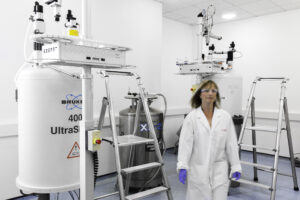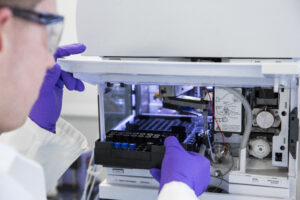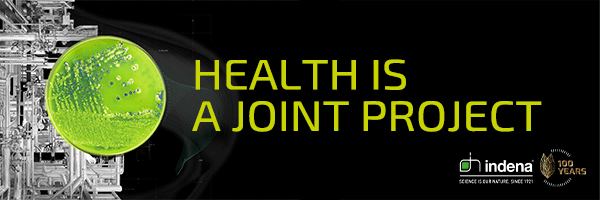Pharmaceuticals
Quantitative Nuclear Magnetic Resonance: The new gold standard release test of the future? 26th January 2022
By Anna Cousens, Global Analytical Business Development Manager at Almac Sciences

In this article, Anna Cousens, Global Analytical Business Development Manager at Almac Sciences, explores how quantitative NMR (QNMR) is now being used as an attractive alternative to traditional HPLC for the determination of structural data of both pharmaceutical active ingredients and impurities.
 Nuclear Magnetic Resonance (NMR) has long been the workhorse ID test used by the pharmaceutical industry for all stages of pharmaceutical development and manufacture, providing reliable structural data of active ingredients and impurities. More recently, although often perceived as inaccurate with sensitivity issues, quantitative NMR (QNMR) has come to the forefront of the industry as an alternative option to traditional HPLC for assay analysis of both active ingredients and impurities.
Nuclear Magnetic Resonance (NMR) has long been the workhorse ID test used by the pharmaceutical industry for all stages of pharmaceutical development and manufacture, providing reliable structural data of active ingredients and impurities. More recently, although often perceived as inaccurate with sensitivity issues, quantitative NMR (QNMR) has come to the forefront of the industry as an alternative option to traditional HPLC for assay analysis of both active ingredients and impurities.
Absolute analysis
QNMR is an absolute analytical method, where an unrelated commercially available reference standard is used to quantify the compound of interest using quantitative 1H NMR experiments. The United States Pharmacopoeia (USP), European Pharmacopoeia (EP), British Pharmacopoeia (BP) detail the use of NMR for quantification with the USP providing guidance on the validation of such methods for use in the quantification of drug product, drug substance and impurities.[1]
GMP-compliant NMR instrumentation with cryoprobe technology is an important investment to allow quicker NMR run times and increased sensitivity, which is often a critical parameter in impurity identification and quantification. This technology allows the observation of multiple nuclei, such as13C, 31P and 19F; commonly used for identification, as well as other complex NMR experiments.
The combination of this technology and the limited material requirements for QNMR has been proven to be an advantage over traditional HPLC method development and validation and practical demonstration of this has been detailed in a white paper published on the use of NMR under GxP by Almac in conjunction with Bruker Biospin.[2]
 QNMR: no reference standard required
QNMR: no reference standard required
Traditional HPLC analysis relies heavily on material-related reference standards (or impurity markers), that can be costly to synthesize, isolate and recertify. These reference standards also add a further layer of complexity to projects, particularly to long term stability studies where the availability and shelf life of standards can put a project at risk. QNMR can be particularly useful for quantitative analysis of new compounds where no reference standard of the material is readily available. This is highly applicable in early-stage API development, where unknown impurities often arise. The use of commercially available reference standards for NMR removes this problem at any stage of the project.
Sample preparation for NMR requires only three components (sample, standard, solvent), there is no requirement to generate calibration curves and the QNMR experiments can take as little as a few minutes to perform. This gives NMR analysis further advantage over traditional HPLC analysis which typically requires complex sample preparation, the generation of calibration curves, and often has extended run times of more than 20 minutes, which leads to increased instrument and analyst time.
Significant time savings
HPLC method development and validation is a significant part of all development programmes with many variables to consider; as well as a more involved sample preparation, a considered approach must be taken with the screening of columns and eluent systems. NMR as an alternative can provide significant time saving as shown in the table below:
| Typical time frame | HPLC | QNMR |
| Method development | 2-4 weeks | 5-8 days |
| Method Validation | 4-6 weeks | 5-10 days |
| GMP Release testing | 1-2 weeks | 2-5 days |
Table1. Example timeframes for analytical work, these will vary depending on the complexity of the method and phase of clinical development.
Impurities that arise in an HPLC assay require further interrogation prior to quantification. This typically takes the form of structural identification by other spectroscopic techniques. Isolation or synthesis of these materials allows genotoxicity to be assessed to ensure the safety of the drug is not adversely affected by the presence of these impurities: where the analysis is performed by QNMR the concentration of each element of the sample can be easily calculated. For example, an early-phase API with an impurity present will require ID and RRT analysis to calculate the concentration using an HPLC assay. The same sample subjected to QNMR will provide a relative concentration of this impurity in the sample down to 0.1% accuracy via further interrogation of the generated data. In accordance with ICH Q3B, the ID Identification threshold for novel drug products can be as low as 0.1% (dependent on the dose strength) so QNMR can provide a vital limit test for these impurities without the need for the costly investigational process to determine concentration via HPLC.
HPLC analysis is also limited by its use of detectors. There is no universal chromatographic detector across all HPLC methods with different compounds requiring UV/Vis,RI or CAD detection. This often leads to problems when multiple compounds require different detectors are present in the same sample. QNMR avoids this pitfall with determination by 1H atoms making the probe suitable for a wide range of compounds.
Reliable results
QNMR can often wrongly be perceived as inaccurate, however, daily calibration of the instrument used is performed as part of GMP compliance to provide accurate results. The use of NIST-certified reference standards in the determination of results also gives reassurance in the results obtained, in addition to the need for replicate agreement to be within 2%w/w and stability of the material determined as part of the method development. The use of cryoprobe technology provides enhanced sensitivity over standard room temperature probe configurations with instruments that have the sensitivity specification limit set for 1H NMR at >1350:1. This sensitivity allows the quantification of low-level impurities in materials in the ppm range.
A single NMR analysis can provide a concentration value either as a percentage or ppm value of a target compound in a sample. This is particularly useful for crude mixtures from manufacturing streams, polymers and natural products.
The new gold standard release test?
In conclusion, QNMR is a powerful analytical tool which overcomes many of the issues inherent when undertaking HPLC analysis. With excellent precision, accuracy and a wide range of applications, assay by NMR may be the new gold standard release test in the future, making HPLC obsolete!
[1]USP (1761) Applications of Nuclear Magnetic Resonance Spectroscopy, EP/BP Appendix II C Nuclear Magnetic Resonance Spectroscopy
[2]https://www.almacgroup.com/knowledge/library/nmr-under-gxp-in-drug-development-manufacturing/


